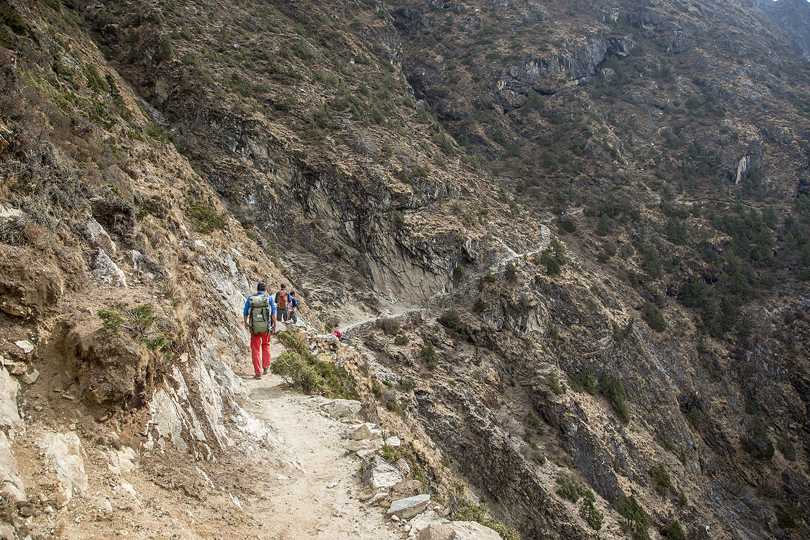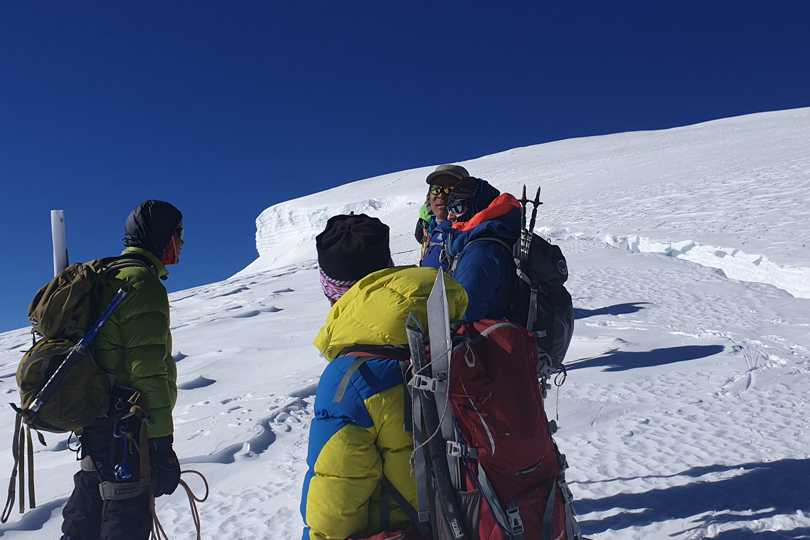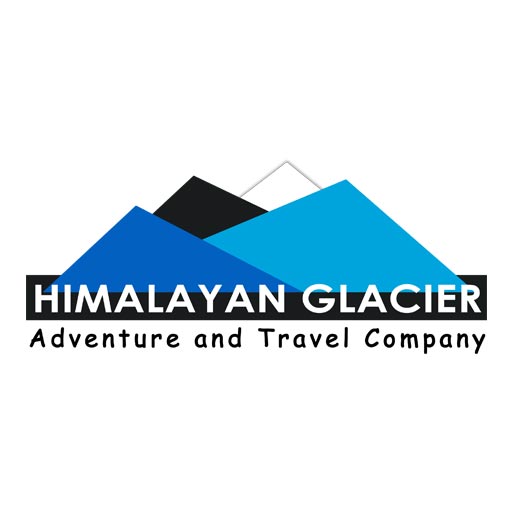Whether you’re planning a long hike to the Himalayas, Mount Kilimanjaro, or even along the Inca Trail to Machu Picchu, you’ll need to do some high altitude hiking training. It may not be specialized like the Everest trekking training, but we need to make sure you’re well prepared for your hiking expedition. So we’ve prepared a list of 10 important hiking training tips to help you prepare adequately for your trip!
- 1. Prepare yourself for trek beforehand
- 2. Climb slowly
- 3. Drink a lot of water
- 4. Monitor your diet
- 5. Avoid cigarettes and alcohol
- 6. Take the right medications
- 7. Be in the company of an experienced local resident
- 8. Keep yourself warm
- 9. Select the right hiking equipment
- 10. Communicate if you are having problems
- What is the Healthy Level of Oxygen to prevent High Altitude Sickness?
- Words of advice for high altitude hiking
1. Prepare yourself for trek beforehand
Muscle cramps, hamstrings, and the symptoms of altitude sickness will ruin your trip. You need to be physically and mentally fit in order to successfully trek in the higher altitudes.
Preparing yourself physically:
If you do not travel frequently, you might want to start doing strength training for hiking. Go on some practice hikes on slightly higher altitudes than you are used to. You can also hit the gym. Going out for 30 minutes run at least 4-5 times a week is one of the best training exercises for hiking.
Even if you are an outdoorsy person who goes out on frequent hikes, we recommend you engage in some physical activities prior to the trek.
Ideally, you can start preparing for your hike 3 months before the trip. You should stop any extreme workouts 7-8 days prior to your flight and give your body enough rest for the upcoming hike.

Preparing yourself mentally:
Once you have planned for a trip to the mountains, embrace it! Be confident that you will complete the trek successfully.
A good way of keeping your mind under control is to practice yogic breathing. The more you understand about how to remain in control, the less panicky you may feel if anything goes wrong during the trip.
You can also perform some light warm-ups and yoga before you begin walking for the day. However, do not overdo the exercises.
2. Climb slowly
In the high altitudes, you are always vulnerable to Acute Mountain Sickness. This is primarily due to thin air in the higher elevation. So, traveling slowly is your best option.
You should not gain more the 500-700 meters of elevation in a single day. This amounts to around 5-6 hours of hiking per day. Moving slowly allows your body to acclimatize to the higher altitude. Plan your travel itinerary so that your body can adjust to the thin air of the mountains.
Going on a high-altitude hike for the first time?
Himalayan Glacier offers you to choose from multiple itineraries that suit your travel needs. Our adventure travel specialists are available 24/7 for any confusion you might have.
3. Drink a lot of water
This is a piece of important hiking advice to keep in mind. The air in the mountainous region is dry. You need to keep your body hydrated to cover up moisture loss.

Carry two water bottles (1 liter each) and a CamelBak type Water Bladder (3 liters) that you can fill each morning before starting the hike. We also recommend that you carry water purification tablets or water filters to purify the water along the trails.
We do not encourage buying water on the hike as there are no facilities to recycle the plastic bottles up in the mountains.
4. Monitor your diet
High altitude hiking burns a lot of energy. You need to take in plenty of light and calorie-rich foods. You can carry a few of your favorite snacks: chocolates, nuts, sweets, etc. to replenish your energy while walking.
Be extremely careful about your food allergies. Since the menu might be using local names of the ingredients used in the cuisine, always make sure to double-check with the hotel personnel and your trip guide.
5. Avoid cigarettes and alcohol
If you are addicted to smoking or drinking, this might be the right time to quit. In the mountainous elevation, your body is constantly adjusting to the decreasing oxygen and increasing cold. Cigarettes and alcohol will decrease the ability of your body to cope with the increasing elevation.
It is even better if you start limiting your intake during your hiking training. Make sure you incorporate that into your hiking training plan so you’re perfectly fit to hike nicotine and alcohol-free!
6. Take the right medications
Always consult with your doctor before you plan for the hike. You will need to know the important do’s and don’ts for your medical conditions before you start your hike. Also, carry the prescription with you, in case you need to purchase your medications.
Altitude sickness Tablets: Diamox or Acetazolamide can prove very vital to prevent AMS.
We also advise you to carry along a few common medicines like antibiotics, painkillers, Paracetamol, Ibuprofen, Aspirin, Advil, cough lozenges.
Never take any sleeping pills during your hike as they are respiratory depressants. You can carry foot powder, insect repellents, hand sanitizer as per your need.
7. Be in the company of an experienced local resident
You can never completely eliminate the possibility of catching Acute Mountain Sickness. So, we advise you to be with a local resident during the entire trek. The native residents are accustomed to high altitudes and can be the friend in need if you fall victim to AMS.
It goes without saying that locals are also great at navigation and communication. They can ensure that you reach your destination safely and stay in lodges without any communication difficulties.
Himalayan Glacier has a team of experienced local guides who have completed countless expeditions in high altitudes. They will definitely be the companion you need during your entire hike, ensuring your safety and maintaining a certain level of comfort.

Himalayan Glacier has a team of experienced local guides who have completed countless treks in the high altitude. They will definitely be a companion you need during your entire trek, ensuring your safety and maintaining a certain level of comfort.
8. Keep yourself warm
High altitude means chilly winds, freezing temperatures, and snowfall. So, the higher altitude hike could come along with risks of snow blindness, frostbite, and hypothermia. Especially when you’re attempting challenging trails like the Everest base camp trek, keeping yourself warm should be your top priority.
Despite the cold, the mountainous terrain receives bright sunlight. Reflected on the snow surface, the sunlight can burn your retina causing snow blindness. You need a good set of wrap-around sunglasses with UV protection.
Frostbite occurs when your skin tissues freeze. Frostbites are typical on fingers, toes, noses, and cheeks. Hypothermia can be considered as an extreme form of frostbite throughout the body. This can be prevented by proper clothing; a great pair of hiking boots, multiple layers of clothing, hand-wear, footwear, and headwear of moisture-wicking fabric.
9. Select the right hiking equipment
Minor details such as the size of your water bottles, buckles of your trekking bag, and zipper of your jackets can affect the overall experience of your treks greatly. It’s unreasonable to micro-manage your hike to ensure nothing goes wrong. However, you can be selective in the equipment you take along.
When hiking in higher altitudes on various terrains such as on the Kilimanjaro trail, choosing the optimal hiking gear is important. So we have prepared a comprehensive everest base camp trek packing list for any high-altitude lodge to lodge hiking that can guide you in selecting the right equipment.

10. Communicate if you are having problems
Timely communication can save your life! If you are having any problems, we recommend you communicate with the hike leader or guide immediately. One of the most common problems we face in high altitudes, is altitude sickness. You should know the basics of dealing with Acute Mountain Sickness during your hike. For now, here are some common symptoms:
● Headache
● Dizziness
● Blurry Vision
● Nausea
● Vomiting
● Fatigue and loss of energy
● Shortness of breath
● Difficulty in breathing
● Problems with sleep
● Loss of appetite
Although problems in falling asleep immediately and a mild headache are common, we advise you to report any sense of uneasiness. You need to return to lower elevations immediately if you are experiencing prominent symptoms of Acute Mountain Sickness.
What is the Healthy Level of Oxygen to prevent High Altitude Sickness?
You must constantly monitor your oxygen level to insure that you do not suffer from high altitude sickness. The following table summarizes the healthy oxygen level in your body during high altitude trekking
| Altitude | Healthy Oxygen Level |
|---|---|
| < 1350m | 90-95% |
| < 2800m | 92-93% |
| < 3400m | 85-90% |
| < 4000m | 80-83% |
| < 5000m | 75-80% |
| < 5500m | 70-75% |
Words of advice for high altitude hiking
- Before the hike: Have a hiking training plan and do some strength training.
- Planning: Allow yourself appropriate time to acclimatize and be selective with your hiking gear.
- During your hikes: Keep yourself warm. No smoking or drinking throughout the trip.
- Don’t forget: Stick to your guide and communicate if you experience symptoms of altitude sickness.
Going on a high altitude hike is a truly exciting experience. Make sure you’re fully prepared with the appropriate hiking training and gear, and you’re good to go! If you want a thorough understanding on how to prepare for your high-altitude hiking, you can talk to our travel experts. Simply message us on Facebook or WhatsApp us at +1-410-307-0007. Grab your hiking boots, let’s go on an adventure!

A leading adventure & tour operator in the Himalayas since 1992, Himalayan Glacier Adventure & Travel Company® is the #1 guiding adventure travel company on Mount Everest Base Camp and beyond with 98% success rate. Each of our holidays is truly a tailor-made package which we design for all ages, groups, families & solo travelers.






